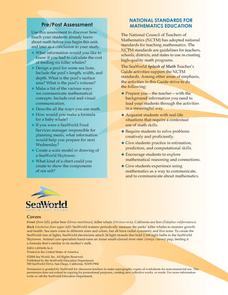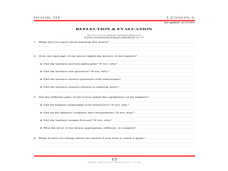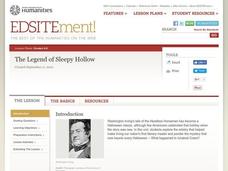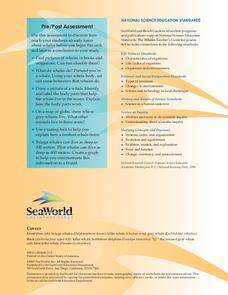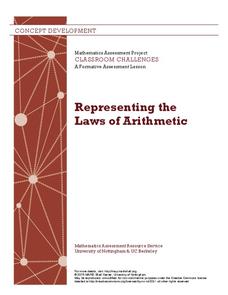Sea World
Splash of Math
How can kids use math to learn about marine life? Combine math skills with science lessons in a resource featuring activities about life in the sea. Kids graph and calculate data, solve complex word problems, measure geometric shapes,...
Roy Rosenzweig Center for History and New Media
Rosa Parks and the Montgomery Bus Boycott
Participants examine two documents related to Rosa Parks and the bus boycott, sources that challenge some of the commonly held preconceptions about Rosa Parks. They then respond to discussion questions to reinforce understanding and...
Curated OER
How to Explore Religious Teachings Without Prejudice
Setting goals plays a major role in becoming a self motivated learner. Students will read and discuss a story, set personal goals, and analyze a sacred prayer. This instructional activity includes: teacher evaluation, goal worksheet,...
Curated OER
Antonyms, synonyms and homophones
Shed light on what antonyms, synonyms, and homophones are. For this lesson, upper elementary schoolers create pairs using an antonym, a homophone, and/or a synonym. Then they play an antonym matching game.
iCivics
Students, Engage!
Discuss as a class some problems that you would like to see changed in your school or community, and then take action! After your young citizens determine the appropriate steps they should take to accomplish their objectives, they will...
Sea World
Penguins
Everyone loves penguins! Learn about the flightless birds of the Antarctic with a series of lessons and activities. From the differences between the 17 species of penguins to the best way to remove oil from a penguin's features, kids...
Federal Reserve Bank
Arts and Economics Infographic Questionnaire
How do careers in the arts contribute to America's gross domestic product? Use an informative infographic that details the economic details of careers in the core arts, including design services, performing arts, and arts education, to...
Curated OER
Knowledge or Instinct? Jack London's "To Build a Fire"
High schoolers examine the relationship of man and nature in "To Build a Fire" and discuss the juxtaposition of knowledge and instinct. They investigate third person, omniscient point of view.
Curated OER
"The Tell-Tale Heart"- It's a Matter of Point of View
How does the point of view of Poe's protagonist in "The Tell-Tale Heart" contribute to the suspenseful tone? Help your middle schoolers identify the point of view in a literary work with this lesson plan, which goes on to discuss the...
Curated OER
What Was Columbus Thinking?
Why is Christopher Columbus one of the most studied figures in history? Upper graders will investigate why Christopher Columbus traveled to the New World and what happened to the native people he encountered. They read and discuss...
Curated OER
Identify and Label Different Types of Angles
Young scholars identify and label acute, obtuse, and right angles within a picture. Using Kid Pix software and digital photos, they manipulate, identify, and label the angles and describe the angles to a classmate.
Curated OER
Where in the World is the Wide Web?
Sixth graders investigate how the web works and how to search effectively. In this Internet use lesson, 6th graders brainstorm positive and negative experiences they have had while on the Internet. Students view two web sites to learn...
Curated OER
The Legend of Sleepy Hollow
Explore Washington Irving's "The Legend of Sleepy Hollow" in this literature analysis lesson. Middle schoolers read and summarize the plot of the story. They then adapt passages for a contemporary audience and analyze the...
National Endowment for the Humanities
Walt Whitman to Langston Hughes: Poems for a Democracy
Explore the idea of democratic poetry. Upper graders read Walt Whitman, examining daguerreotypes, and compare Whitman to Langston Hughes. They describe aspects of Whitman's I Hear America Singing to Langston Hughes' Let America Be...
Curated OER
Bud, Not Buddy: Directed Reading Thinking Activity
Here’s a reading strategy that can be used with any text. Class members examine portions of a novel, and make predictions about the theme or subject matter of the book. Although designed for Christopher Paul Curtis’s Newbery Medal...
Curated OER
DR-TA Reading Strategy
Foster critical thinking skills by using the DR-TA Strategy with Jonathan Swift’s “A Modest Proposal.” Class members read portions of the essay, stop and discuss what is happening, make predictions based on evidence from the text, and...
Curated OER
Dandelion Wine: Questioning Strategy
Readers of Dandelion Wine work in groups to develop questions on four levels (right there, think and search, the author and you, and on my own) about Chapter 34 of Ray Bradbury's reflection on the joys of summer. Groups jigsaw and then...
Curated OER
Phineas Gage: The Teenage Brain and Connections: Free Choice Activity
During this lesson, which is all about making connections, learners watch a documentary about the teenage brain and connect it to Phineas Gage: A Gruesome but True Story About Brain Science, their own lives, and the world.
Mathematics Assessment Project
Representing Quadratic Functions Graphically
Sometimes being different is an advantage. An engaging activity has scholars match cards with quadratic functions in various forms. Along the way, they learn about how each form highlights key features of quadratic functions.
iCivics
Yeah, But...
Impress upon your young learners the importance of formulating counter arguments based on facts and not opinions. This resource is meant to strengthen arguments designed in a previous lesson, but could also be used as a stand-alone...
Sea World
Endangered Species
Study different endangered species with several activities that incorporate math, science, language arts, and research strategies. A great addition to your lesson on conservation or Earth Day.
Sea World
Whales
A whale of a lesson is sure to intrigue your elementary oceanographers! Learn about the mammals of the sea with a series of activities about whales, dolphins, and porpoises. Kids complete worksheets about the anatomy of a whale, create a...
Mathematics Assessment Project
Representing the Laws of Arithmetic
Sixth graders connect numerical expressions to geometric area. They first complete an assessment task requiring them to identify area models for numerical expressions. Learners then participate in an activity to match area models to...
Mathematics Assessment Project
Solving Quadratic Equations
Scholars first complete an individual assignment using a quadratic equation to model the movement of a bus around a corner. Learners then discuss their solutions with classmates and analyze the provided sample responses.


